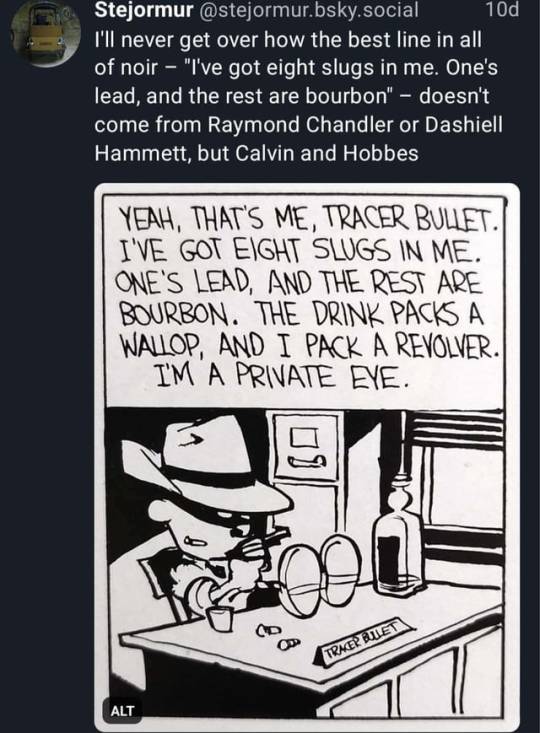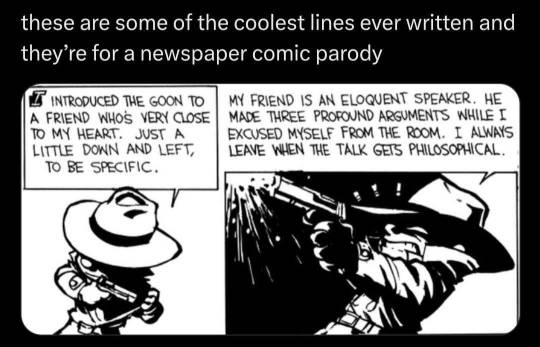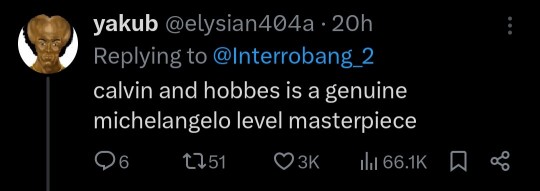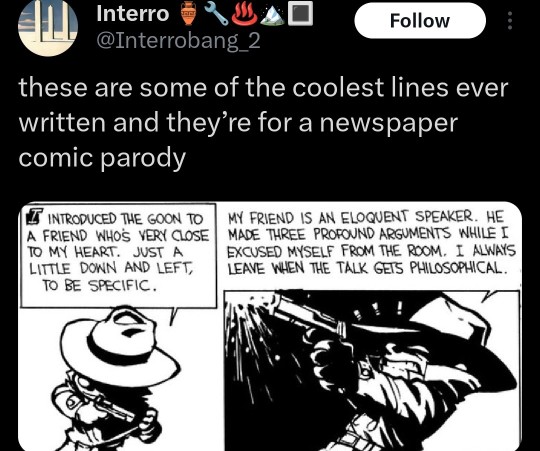#calvin…
Explore tagged Tumblr posts
Text


calvin and hobbes
86K notes
·
View notes
Text
I thinks folks expressing incredulity at the quality of the writing and composition in Calvin and Hobbes are often missing the context that Bill Watterson is arguably the most influential sequential artist of his generation. Like, this is a guy who once told the editors of nationally syndicated newspapers to go fuck themselves when they wanted to mess with his panel layouts, and not only did he keep his job, he got his way. He could have had literally any gig he wanted, and he chose to be the Sunday funnies guy because that's what made him happy. He's basically the Weird Al of sequential art.
57K notes
·
View notes
Text
As a kid, I was really upset that Bill Watterson wouldn't license Calvin & Hobbes so I could have plushies or so there would be a Saturday morning cartoon. Now, I realize his resistance is the reason we don't have a Calvin & Hobbes DreamWorks movie starring Chris Pratt.
59K notes
·
View notes
Text

15K notes
·
View notes
Text
some important calvin and hobbes facts in case you haven't read the original comic strip in a long time or only absorbed stuff on it from memes and out of context bits on here:
Calvin's last name has never been given, and neither has any of his parent's names. This was actually why his uncle Max only showed up for a brief storyline; the creator of the comic, Bill Watterson, ultimately felt that while it was fine to have him as someone for his parents to talk to, it felt far too awkward to never have Max refer to them by name and he never made a return appearance.
The general tone of the comic is fairly light-hearted, with a big emphasis on goofy slapstick comedy contrasted by clever wordplay and often surprising adult-centered jokes that'll hit you like a slap. A big part of the comedy is, as Watterson put it (paraphrased) "It's really funny to me when people express deeply stupid ideas with really fancy terminology." One notable example you might have seen is that one bit where Calvin asks his mom for money to buy a Satan-worshiping rock album and his mom replies that there's nothing genuine about them and they're just putting on the attitude for shock value, and comisserates with Calvin as he deplores that mainstream nihilism can't be trusted. He concludes that childhood is disillusioning.
There is a LOT of criticism of the extreme materialism and selfish mentality of the late 80s, when the comic was initially written. This may go a long way to explain how its aged so well; much of what it criticizes resonates well with people today.
Bill Watterson views comic strips a legitimate form of artwork, and repeatedly fought to have more space to draw more beautiful and artistic backgrounds, which was a very hard fight and unpopular even with other comic strip artists. He eventually did win some compromises and a lot of Calvin And Hobbes' artwork shows it, with the use of space to indicate time as well as a sharp contrast between the often plain environments of mundane life contrasted by the wildly beautiful imagery of Calvin's imagination (which often sports realistic depictions in an art shift of sorts).
Hobbes is explicitly not an imaginary friend, by word of Watterson himself. We don't know WHAT he is exactly, and Hobbes is apparently unaware of the strange nature of his reality; people look at him and only see an ordinary stuffed tiger plushie, but he has a tangible effect on the world that would be physically impossible for Calvin to do on his own. He's apparently been around for a while, and was apparently around when Calvin was a young baby.
On that note; Hobbes has implicitly killed (notably treated as both a gag and also with the vibe of 'he's a tiger, duh') and while he doesn't do it again on-screen, he doesn't have any moral issues about it. Calvin claims that he's never had trouble bringing Hobbes to school because the last time he did, Hobbes killed and ate a bully named Tommy Chestnut and simply comments that it was gross and he needed a bath. Calvin's tried to repeat this again, but Hobbes was grossed out at the thought having to eat a kid raw and not being allowed to use an oven first, or complaining that children are too fattening.
Hobbes became gradually less human-like in body language and more like an actual cat in both body language and behavior; this was due to Watterson drawing more inspiration from his cat, who also inspired a lot of Hobbes' running gags, such as pouncing on Calvin when he got home. Several years into the syndication of the strip, Watterson's cat passed away, and he did a tribute to her with a comic strip of the two of them agreeing to try to dream together so they can keep playing when they have to sleep; Watterson's commentary (if I recall right), remarks on his cat: "We can see each other again in dreams."
45K notes
·
View notes
Text

Love this strip
82K notes
·
View notes
Text

17K notes
·
View notes
Text

My perfect thick idiot son, Calvin, who has never done anything wrong in his entire life except today when I let him climb my young redbud tree and he went to the highest branch and wedged himself in the crook of it and wouldn't budge and he's so big I was afraid that he might break the branch so I had to get a stepladder and get him down while the neighborhood jays that come by for peanuts whenever they see me in the yard freaked out and sat screaming on the fence to warn me that there's a snake very near me because I'm obviously too stupid to see it and clearly in mortal peril.
#thanks Calvin#thanks jays#snake#snakes#reptile#reptiles#reptiblr#rat snake#Texas rat snake#scaleless Texas rat snake#rat snake = brat snake#Calvin
9K notes
·
View notes
Text
So usually when an imaginary friend is a real thing in a story, it’s either a demon or a ghost or some supernatural boogeyman that probably wants to eat the kid they’ve befriended (Mama, a couple of the Paranormal Activity movies), or “imaginary friends” are just treated as a real thing in the setting, and if a child just thinks hard enough they can manifest a friend into existence (Foster’s Home for Imaginary Friends, Happy).
And somewhere in the middle is an area where the imaginary friend in question is real and they are supernatural, but they aren’t malevolent, and they aren’t entirely honest about what they are. Like maybe they’re a fairy or a god or some kind of boggle from mythology, but they just got caught by a six year old and they don’t have time to get into it, so they just go “…Yes. I’m your imaginary friend. We haven’t met. How do you do.” And then they stick around because they do love this kid, and if you’re a boggle from mythology in the modern day good food is really hard to come by.
And at some level. That’s what I think Hobbes is.
#imaginary friends#calvin and hobbes#hobbes lives in some kind of level of existence calvin isn’t aware of#but fundamentally calvin doesn’t seem to care#to calvin hobbes is a particularly well spoken and occasionally insufferable friend who happens to be shaped like a tiger#and who he loves to the very bottom of his soul#all of which is true and so hobbes isn’t in a rush to correct him#10k#20k#30k#40k
41K notes
·
View notes
Text

18K notes
·
View notes







